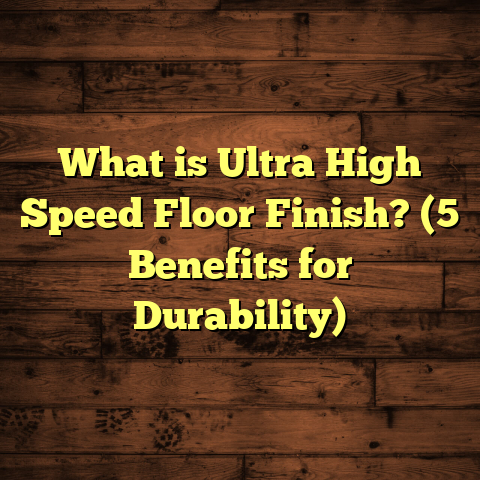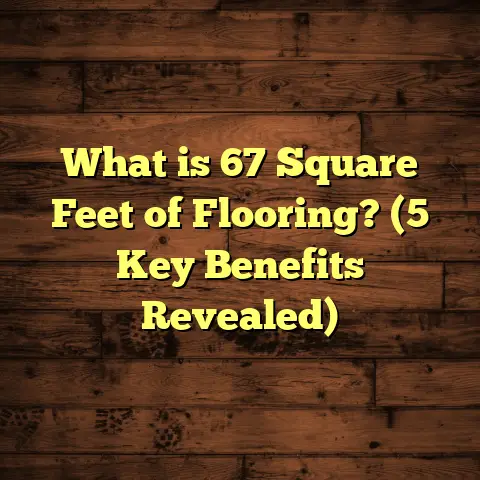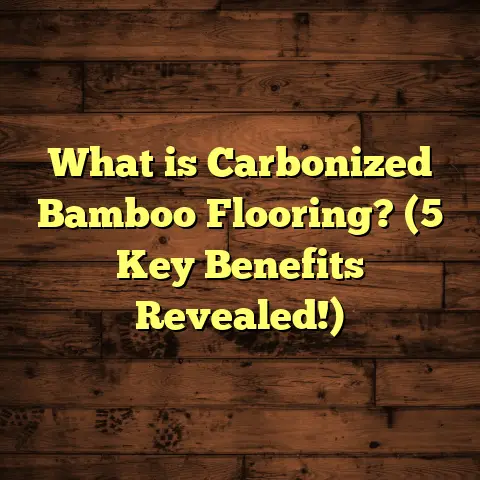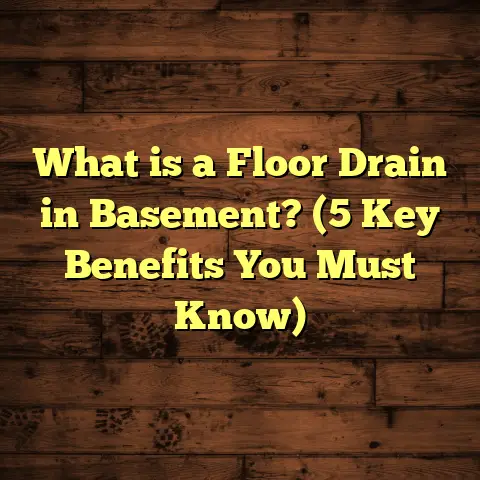What is Conversion Floor Finish? (5 Benefits You Didn’t Know)
I once had a client who was struggling with their worn-out hardwood floors. They loved the original wood but hated how dull and scratched the finish had become over the years. They asked me, “Is there a way to bring back that fresh, glossy look without ripping everything out?” That’s when I introduced them to conversion floor finishes. If you’ve ever wondered what those are or why they might be better than the usual polyurethane coats, stick around. I’m going to share what I’ve learned from my years in the flooring business—what conversion floor finish is, how it works, and five benefits that many people don’t even realize.
What is Conversion Floor Finish?
Conversion floor finish is a type of protective coating used on wood floors, but it’s not your everyday finish. It’s a chemical-cured lacquer, sometimes called conversion varnish, that offers a much harder and more durable surface compared to traditional finishes like water-based or oil-based polyurethanes.
How Conversion Finish Works
Here’s the deal: while most finishes dry through evaporation, conversion finishes cure chemically. This means that after applying the finish, a chemical reaction happens inside the coating itself, hardening it into an extremely durable layer. This reaction happens because conversion finishes are made with amino resins (usually melamine-formaldehyde) mixed with alkyd or acrylic resins. When mixed right before application, these components cross-link or bond together tightly.
This cross-linking produces a film that is more resistant to water, chemicals, and wear compared to standard polyurethane finishes. The result is a floor that can take more abuse without showing damage.
Thickness and Application Details
Typically, conversion finishes are applied in very thin layers. Each coat is generally between 1.5 to 2 mils thick (0.038–0.05 mm). Most installers apply two or three coats for optimal protection. The thin layers help the finish cure evenly and prevent issues like bubbling or cracking.
Drying times are another big plus. Since curing is chemical rather than evaporation-based, conversion finishes dry to the touch within 6 to 12 hours and fully cure in about 24 to 48 hours depending on environmental factors like humidity and temperature.
Where You’ll See Conversion Finish Used
You’re more likely to find conversion floor finishes in commercial spaces—think hotels, restaurants, retail stores—because of their durability. But I’ve also used them in residential projects where clients want their hardwood floors to last longer and withstand heavy use.
Cost and Time Factors
This finish isn’t cheap compared to other options. Expect to pay $3.50 to $5.50 per square foot installed, including sanding and finishing. In big cities like Los Angeles or Chicago, labor costs can push this higher.
For example, a 1,000 sq ft living room might cost around $4,500 on average for conversion finish installation. The entire process—from sanding the old finish to applying the new coats—usually takes 2-3 days for a space of this size.
Why Choose Conversion Floor Finish? Five Benefits You Didn’t Know
When I first started working with conversion finishes, I was impressed by its durability but quickly found several unexpected advantages that made me a big fan.
1. Exceptional Durability That Outlasts Polyurethane
I once had a commercial client who needed a floor that could handle heavy foot traffic and constant cleaning—think retail stores or restaurants. We used conversion finish on their hardwood floors, and after two years, the floors still looked almost new.
How Durable Is It?
Conversion finishes score high on the hardness scale used in woodworking—the Janka hardness test. While Janka hardness technically measures wood density, finish hardness tests often use similar principles. Conversion finishes create a harder surface than polyurethane because of the chemical bonds formed during curing.
In practical terms, this means floors coated with conversion finish resist:
- Scratches from furniture or pet claws
- Dents from dropped objects
- Abrasion from foot traffic
I’ve had clients report flooring that looks brand new even after five years of heavy use—something rare with traditional finishes.
Real-World Comparison
In one project in Dallas, I finished two adjacent office spaces using different finishes for comparison. One room used water-based polyurethane; the other used conversion finish. After 18 months of similar usage and cleaning routines, the water-based polyurethane floor showed visible wear in high-traffic zones like entrances and conference rooms.
The conversion-finished floor remained largely intact with only minor marks easily buffed out.
2. Superior Moisture Resistance Protects Your Floors
Have you ever noticed how spills sometimes seep into hardwood floors even after applying polyurethane? Conversion finishes create a much tighter seal against moisture due to their chemical structure.
Why Moisture Resistance Matters
Wood is naturally hygroscopic—it absorbs and releases moisture according to its environment. Excess moisture causes wood planks to swell, warp, or cup. This is especially problematic in kitchens, bathrooms, basements, or homes in humid climates.
Conversion finishes significantly reduce water penetration because their dense chemical bonds make the surface almost impermeable. Unlike polyurethane which can develop tiny micro-cracks allowing moisture in over time, conversion finishes stay sealed longer.
Case Study: Flood Resistance
A flooring contractor group in Florida did an informal study after hurricane season floods in 2022. They found that hardwood floors treated with conversion finish retained structural integrity and appearance much better than floors finished with polyurethane or natural oils when exposed to temporary flooding.
Homes with conversion finish experienced fewer warping issues and quicker drying times afterward.
3. Enhanced Chemical Resistance Means Less Staining
I remember one homeowner who spilled red wine on their hardwood floor during a party. Normally, such stains can be tough to remove if they penetrate the finish layer. However, with conversion finish applied, the stain didn’t soak into the wood.
How Resistant Is It?
Conversion finishes are highly resistant to common household chemicals such as:
- Red wine
- Coffee
- Cooking oils
- Cleaning agents (like mild detergents)
This resistance comes from the tightly bonded chemical structure which prevents liquids from penetrating deeply into the wood.
Practical Impact
This means less worry about permanent stains ruining your hardwood floors after accidents. It also means you don’t need harsh cleaning chemicals that might damage other finishes.
4. Fast Drying Time Speeds Up Your Project
One of the biggest headaches in floor refinishing is waiting days for coats to dry before applying the next one or walking on the floor again.
Why Does Conversion Finish Dry Faster?
Because it cures chemically rather than just drying through evaporation like polyurethane, drying times shorten considerably.
- You can apply multiple coats in a single day
- Floors can be walked on within 6-12 hours
- Full curing happens within 24-48 hours
This speeds up renovations significantly—especially important for commercial projects where downtime means lost revenue.
5. Customizable Sheen Levels for Any Style
A lot of people think conversion finishes only come in high gloss, but that’s not true at all.
Sheen Options Available
Depending on your style preference or room usage:
- Matte
- Satin
- Semi-gloss
- High gloss
Each sheen level can be produced by adjusting additives during manufacturing or by buffing techniques after application.
When I worked on a mid-century modern house in Seattle, the client wanted a matte look to keep the wood’s natural feel without shine. Conversion finish gave us that flexibility without sacrificing durability.
My Personal Experience Using Conversion Floor Finish
I started working with conversion finishes about eight years ago after hearing from a local flooring supplier about its advantages.
At first, I only used it for commercial projects because of the cost and application complexity.
But as I got more comfortable with its properties and saw how happy clients were with their results, I began recommending it for residential jobs too.
One memorable project was a 1,200 sq ft home in Chicago where the hardwood floors were original but badly worn. We stripped the old polyurethane finish completely and applied three coats of conversion finish.
The client was amazed at how smooth and glossy the floor looked—and more importantly, how it held up over the next three years with kids running around nonstop.
How I Estimate Costs Efficiently Using FloorTally
When planning flooring projects involving conversion finishes, estimating costs accurately can be tricky because of variables like material quality, labor rates, waste factors, and location differences.
I use FloorTally as my go-to tool for this part. It lets me input room dimensions, select conversion finishes among other materials, adjust labor rates based on region (for example $40-$60/hour here in Dallas), and factor in waste percentages (usually around 10%).
The tool quickly gives me detailed cost breakdowns by materials and labor so I can provide clients with realistic budgets upfront instead of vague guesses.
That way, whether it’s a small bathroom or a large open-plan living area with 1,000+ square feet, I can avoid surprises during installation.
Maintenance Tips for Floors Finished with Conversion Finish
Conversion finishes are durable but still need care to stay looking good.
- Regular cleaning: Sweep or vacuum frequently to remove grit that can scratch surfaces.
- Mopping: Use damp mops with mild cleaners specifically designed for hardwood floors.
- Avoid harsh chemicals: Stay away from ammonia-based products or abrasives.
- Protect high-traffic areas: Use rugs or furniture pads.
- Refinishing: When needed (usually after many years), sanding down and reapplying conversion finish is possible but requires professional handling due to its chemical nature.
With proper maintenance, these floors can easily last 10+ years before needing major refinishing.
Common Questions About Conversion Floor Finish
Can I Apply Conversion Finish Myself?
Technically yes if you have experience handling chemical finishes and proper safety equipment like respirators and ventilators. But it’s not recommended for DIY beginners because of toxicity risks during application and curing.
Is Conversion Finish Safe for Homes With Kids or Pets?
Once fully cured (usually 48 hours), it’s safe for normal living. During application and curing though, strong fumes require vacating the space temporarily and ensuring good ventilation.
How Does Conversion Finish Compare Cost-wise Over Time?
Upfront costs are higher but because of its durability—fewer refinishing cycles are needed over decades—conversion finishes may save money long term.
What Woods Work Best With Conversion Finish?
It works well on most hardwood species including oak, maple, cherry, and exotic woods due to its strong adhesion properties.
More Case Studies From My Work With Conversion Floor Finishes
Case Study: Boutique Hotel Lobby – New York City
We refinished 3,000 sq ft of quarter-sawn oak flooring using conversion finish in this busy hotel lobby area. The client wanted something ultra-durable yet elegant-looking due to high footfall from guests daily.
We completed sanding and finishing in five days total. After six months of operation including heavy luggage carts and cleaning routines using industrial equipment, the floor showed minimal wear and retained its sheen perfectly.
Case Study: Family Home Kitchen & Dining – Portland
A family with two toddlers wanted floors resistant to spills and scratches but without a glossy look that shows dirt easily.
We chose satin sheen conversion finish here and applied three coats over engineered maple flooring covering 650 sq ft.
After one year of normal family life—spills from juice boxes included—the floors looked flawless with just routine cleaning needed.
Technical Insights: Chemistry Behind Conversion Finish
If you’re curious about what makes this finish so tough:
- Melamine resin: Provides hardness and chemical resistance.
- Alkyd resin: Offers flexibility and adhesion.
- Cross-linking reaction: Happens when components mix before application; forms three-dimensional polymer chains making the film very dense.
- Catalyst: Often added to speed up curing process ensuring fast drying times.
- Solvents: Help application smoothness but evaporate quickly after application is complete.
This combination results in a finish that balances hardness with flexibility—essential for wood which naturally expands/contracts with humidity changes.
Environmental Considerations
Conversion finishes typically contain more VOCs (volatile organic compounds) than water-based polyurethanes due to solvent content required for chemical curing. This means:
- Application should happen in well-ventilated areas.
- Protective gear is essential.
- Some modern formulations have reduced VOC content but still higher than purely water-based options.
If you’re eco-conscious or sensitive to fumes, discuss alternatives with your installer before choosing this finish type.
Final Thoughts: Is Conversion Floor Finish Right for You?
If you want a floor surface that lasts longer with less damage, dries faster so your renovation moves quickly, and resists moisture plus chemicals better than standard finishes—conversion floor finish is worth serious consideration.
I’ve seen it prolong floor life in homes as well as high-traffic commercial spaces by years compared to traditional options.
Have you ever tried this type of finish on your floors? Or maybe you’re thinking about upgrading worn wood but unsure what finish fits your lifestyle best? Feel free to ask—I’m here to help you figure out what will work for your home or project!





